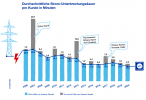So much doom and gloom, one might think that many are hoping that the transition to CO2 neutral energy production will not succeed

It is clear that without the expansion of short- and long-term energy storage, there will be problems.
Despite all the existing problems, the reality looks quite good for countries with a high share of renewable energy. Power grid stability is increasing with the expansion of renewables.
Taking Germany as an example (where I know the details best), here is the share of renewable energy in electricity production:
View attachment 241106
Source:
energy-charts.info
The share of renewable energy in electricity production is currently around 50%. The stability of the German power grid has tended to increase with the expansion of renewable energy generation.
In the graph below you can see that for the year 2020 the average power interruption duration per customer was 12.5 minutes - 10.2 minutes causes without force majeure (in blue) and 2.3 minutes caused by force majeure like hurricanes and floods... (in grey) per customer in the year 2020. The trend of the last 14 years indicates an increase in power grid stability with the growth of renewable energy.
View attachment 241107
Source: https://www.vde.com/de/fnn/aktuelles/00-2021-09-01-stoerungsstatistik
As a result of the increasing "remunicipalization" of electricity grids (electricity grids privatized by municipalities in the 1980s are increasingly being operated by the municipalities themselves again) and local electricity production, grid stability is likely to increase further.





